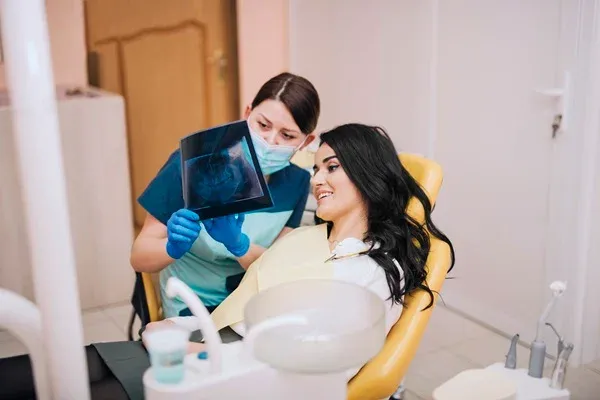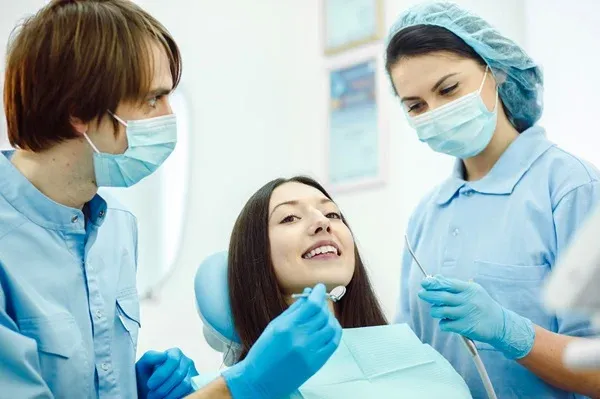Assessment and Evaluation for Surgical Orthodontics
Dr. Hoss Abar
This blog will discuss the importance of assessment and evaluation in surgical orthodontics and the factors considered before deciding on the appropriate treatment plan.
Pre-treatment assessment
- Initial Consultation: The journey begins with an in-depth consultation, during which the orthodontist gathers pertinent medical and dental history, evaluates the patient's concerns and expectations, and establishes rapport.
- Orthodontic Examination: A meticulous orthodontic examination ensues, leaving no stone unturned in assessing dental occlusion, alignment, and bite discrepancies. This thorough evaluation aids in identifying malocclusions, dental crowding, and any existing orthodontic issues.
- Radiographic Evaluation: Radiographic imaging, including X-rays and Cone Beam Computed Tomography (CBCT), provides valuable insights into skeletal structures, dental positioning, and potential anatomical abnormalities. These images aid in treatment planning and surgical decision-making.

- Facial Analysis: Facial photographs and cephalometric analysis provide a comprehensive facial assessment. Analysis of facial proportions, soft tissue profiles, and asymmetries guides treatment planning, ensuring harmonious facial aesthetics post-surgery.
- Airway Assessment: Evaluation of the upper airway is integral, especially in skeletal discrepancies impacting breathing and sleep quality. Assessing airway dimensions and function informs treatment decisions, promoting optimal respiratory function post-surgery.
Diagnostic Tools and Techniques
- Cephalometric Analysis: Cephalometric radiographs provide invaluable insights into craniofacial structures, allowing orthodontists to analyze skeletal relationships, dental positions, and soft tissue profiles. Measurements obtained from cephalometric analysis aid in treatment planning and predicting post-surgical outcomes.
- Facial Photographs: High-quality facial photographs capture facial features from various angles, enabling detailed analysis of facial symmetry, proportions, and soft tissue contours. These images are valuable reference points for treatment planning and assessing aesthetic outcomes post-surgery.
- Three-Dimensional Imaging: Three-dimensional imaging technologies, such as cone-beam computed tomography (CBCT) and intraoral scanners, offer a comprehensive view of dental and skeletal structures in three dimensions. This detailed visualization enhances treatment planning accuracy and facilitates precise surgical execution.
- Model Analysis: Dental models constructed from impressions provide a tactile representation of the patient's dentition, facilitating occlusal analysis, tooth movement simulations, and the fabrication of surgical splints or appliances.
- Virtual Surgical Planning (VSP): VSP software lets orthodontists and surgeons plan surgical procedures digitally by manipulating three-dimensional patient anatomy models. This technology allows for precise pre-surgical simulations, optimizing surgical outcomes and reducing intraoperative complexities.
- Airway Assessment Tools: Advanced diagnostic tools, such as sleep studies and acoustic pharyngometry, aid in evaluating airway dimensions, breathing patterns, and potential obstructive sleep apnea. These assessments inform treatment decisions, ensuring comprehensive management of airway-related issues.
Collaboration with Specialists
- Orthodontist-Oral Surgeon Collaboration: Orthodontists and oral and maxillofacial surgeons work hand in hand to develop comprehensive treatment plans tailored to each patient's needs. Orthodontists focus on pre-surgical orthodontic preparation, aligning teeth, and optimizing occlusion to facilitate surgical correction. At the same time, oral surgeons perform the surgical procedures necessary to reposition the jaws and achieve facial balance.
- Periodontal and Prosthodontic Collaboration: In cases where periodontal health or prosthetic rehabilitation is essential for achieving optimal treatment outcomes, collaboration with periodontists and prosthodontists is vital. Periodontists address gum health and bone support, ensuring a stable foundation for orthodontic and surgical interventions. Prosthodontists may be involved in restoring dental function and aesthetics post-surgery.
- Communication and Treatment Planning Meetings: Regular communication and interdisciplinary treatment planning meetings facilitate collaboration among specialists. These meetings allow for exchanging information, discussing treatment goals, and coordinating care, ensuring a cohesive approach to patient management.
- Surgical-Orthodontic Timing: Close collaboration between orthodontists and oral surgeons ensures optimal timing of surgical intervention within the overall treatment timeline. Orthodontic preparation aims to align teeth and establish a stable occlusion before surgery, while post-surgical orthodontic adjustments fine-tune tooth positions and occlusal relationships.
- Post-Surgical Follow-Up and Rehabilitation: Collaboration extends beyond the surgical phase to encompass post-operative care and rehabilitation. Orthodontists monitor post-surgical healing, adjust orthodontic appliances as needed, and collaborate with other specialists to address residual concerns or complications.
- Patient Education and Support: Collaborative efforts also involve patient education and support, ensuring patients are well-informed about the treatment process, expected outcomes, and post-operative care instructions—clear communication and ongoing support foster patient confidence and compliance throughout their surgical orthodontic journey.
Surgical Phase Evaluation
- Intraoperative Assessment: The orthodontic and surgical teams collaborate closely to achieve the planned surgical corrections during surgery. Intraoperative assessment involves verifying the accuracy of surgical movements, ensuring proper jaw alignment, and addressing any unforeseen anatomical variations or challenges encountered during the procedure.
- Immediate Post-Surgical Monitoring: Following surgery, patients are closely monitored in the immediate post-operative period to assess vital signs, manage pain and discomfort, and monitor for any signs of complications such as bleeding or swelling. Regular assessments by the surgical team ensure early detection and intervention if needed.
- Wound Healing and Stability: Evaluation of wound healing and post-operative stability is essential for assessing the success of the surgical intervention. Monitoring the progress of soft tissue healing, jaw positioning, and strength of skeletal corrections allows for timely adjustments and ensures optimal long-term outcomes.
- Orthodontic Adjustments: Post-surgical orthodontic adjustments are initiated once the patient sufficiently recovers from surgery. Evaluation of occlusion, dental alignment, and interarch relationships guides the orthodontist in making necessary adjustments to orthodontic appliances, such as braces or aligners, to continue refining the patient's bite and smile.
- Management of Complications: Despite meticulous planning and execution, complications may arise during surgery. Prompt identification and management of complications, such as malocclusion, nerve injuries, or infection, are essential for minimizing adverse outcomes and optimizing patient recovery.
Post-Treatment Evaluation
- Stability Assessment: Evaluating the stability of surgical corrections is essential for determining the success of the treatment. Monitoring the position of the jaws, dental occlusion, and facial symmetry over time helps assess the long-term stability of the surgical outcomes.
- Occlusal Function: Assessing occlusal function and bite stability is vital for determining the functional efficacy of the treatment. Patients' ability to bite, chew, and speak comfortably post-treatment indicates the successful alignment of the jaws and teeth.
- Aesthetic Outcome: Evaluating the aesthetic outcome of surgical orthodontic treatment involves assessing facial symmetry, profile balance, and smile aesthetics. Comparing pre-operative and post-operative photographs allows for objective analysis of changes in facial appearance and overall satisfaction with the aesthetic results.
- Airway Evaluation: Monitoring airway dimensions and function post-treatment is particularly important in cases where surgical interventions were performed to address airway issues such as obstructive sleep apnea. Assessing improvements in breathing patterns and sleep quality helps determine the treatment's effectiveness in addressing airway concerns.
- Periodontal Health: Regular assessment of periodontal health and stability is essential for monitoring gum health and bone support following orthodontic and surgical interventions. Maintaining optimal periodontal conditions contributes to the long-term stability of the treatment outcomes.
- Patient Satisfaction: Gathering feedback from patients regarding their satisfaction with the treatment outcomes, overall experience, and quality of life post-treatment provides valuable insights into the success of the surgical orthodontic care. Addressing any remaining concerns or issues ensures continued patient satisfaction and enhances the overall treatment experience.
- Long-Term Follow-Up: Long-term follow-up appointments are scheduled to monitor the stability of treatment outcomes and address any late complications or relapse. Regular check-ups allow for timely intervention if any issues arise, ensuring continued success and patient well-being in the years following treatment.

Contact your Pinole dentist, Dr. Hoss Abar, DDS, MSD at Abar Orthodontics, to learn more about the Assessment and Evaluation for Surgical Orthodontics.
Resource:
What are my non-surgical treatment options for a gummy smile?
*This media/content or any other on this website does not prescribe, recommend, or prevent any treatment or procedure. Therefore, we highly suggest that you get the advice of a qualified dentist or other medical practitioners regarding your specific dental condition.
More To Explore
About Us
We believe that every patient deserves to feel confident about their smile. Years of experience creating beautiful and flawless smiles.
Opening Hours:
Monday - Thursday: 8:00 AM - 5:00 PM
Friday: 8:00 AM - 12:00 PM
Saturday - Sunday: Closed
Abar Orthodontics, Pinole, CA
1500 Tara Hills Drive., Suite 204
Pinole, CA 94564
Abar Orthodontics, San Leandro, CA
145 East 14th street., #100
San Leandro, CA 94577
© 2026Abar Orthodontics | All rights reserved | Powered by:Vigorant, Inc.
